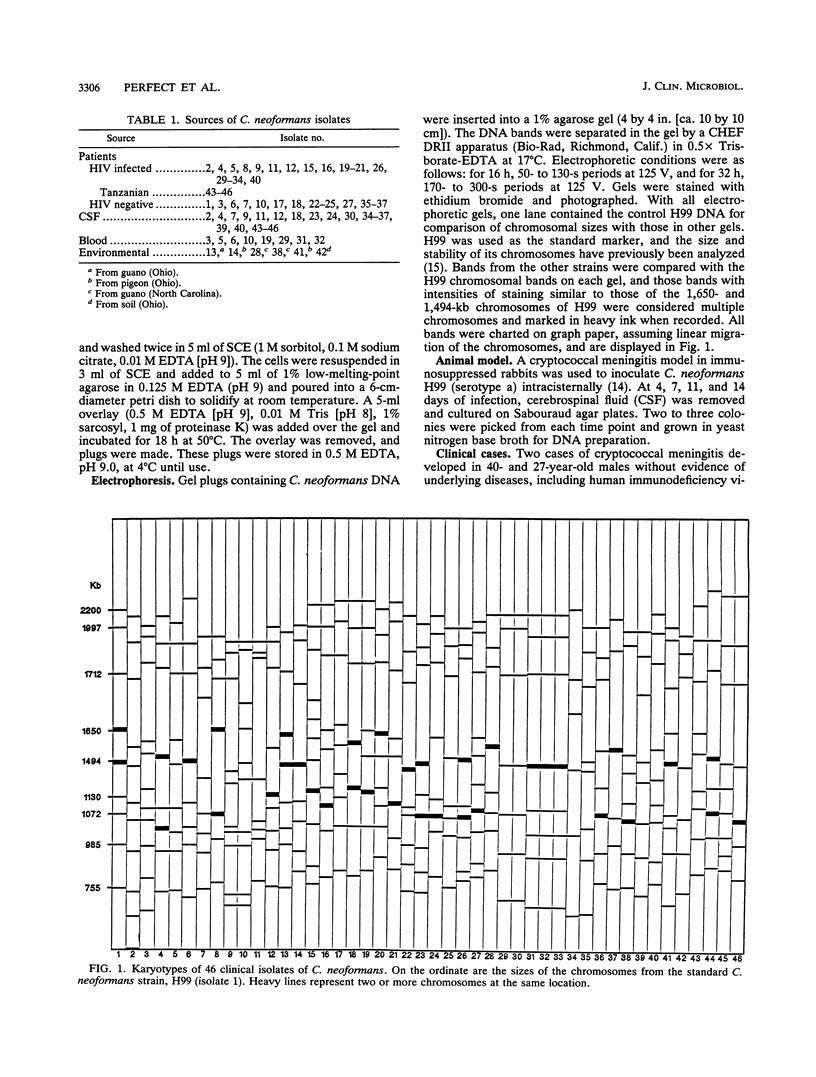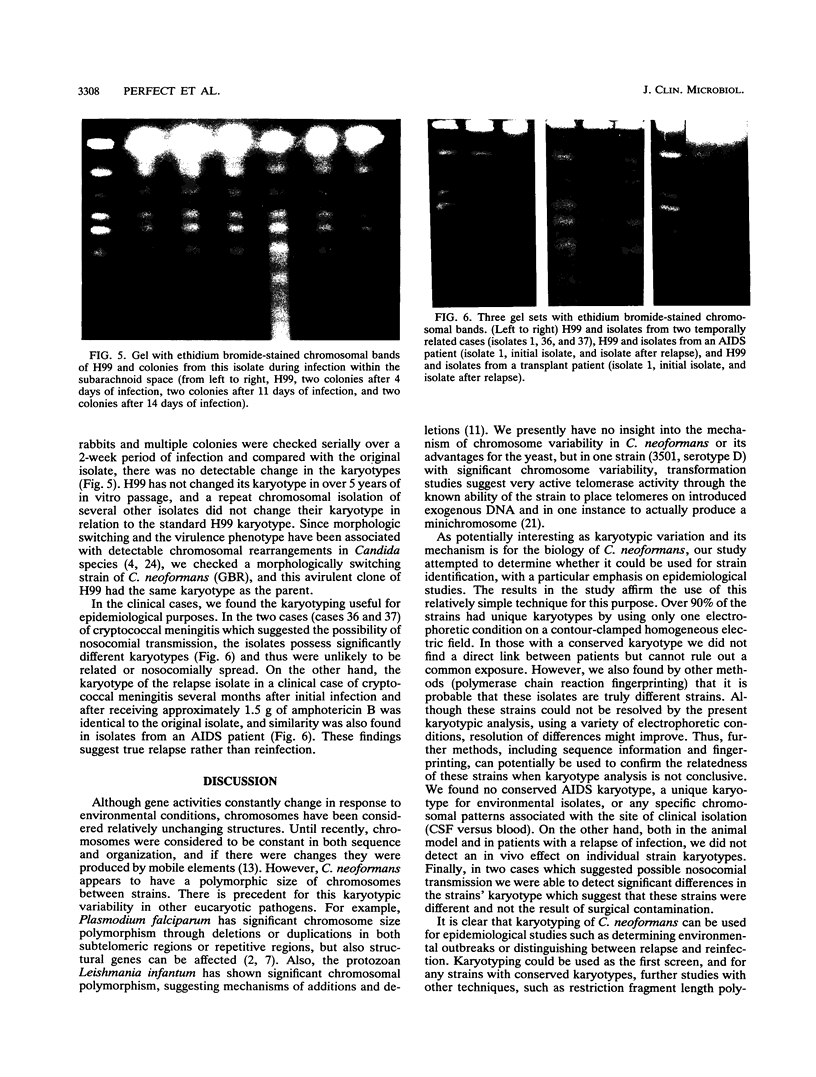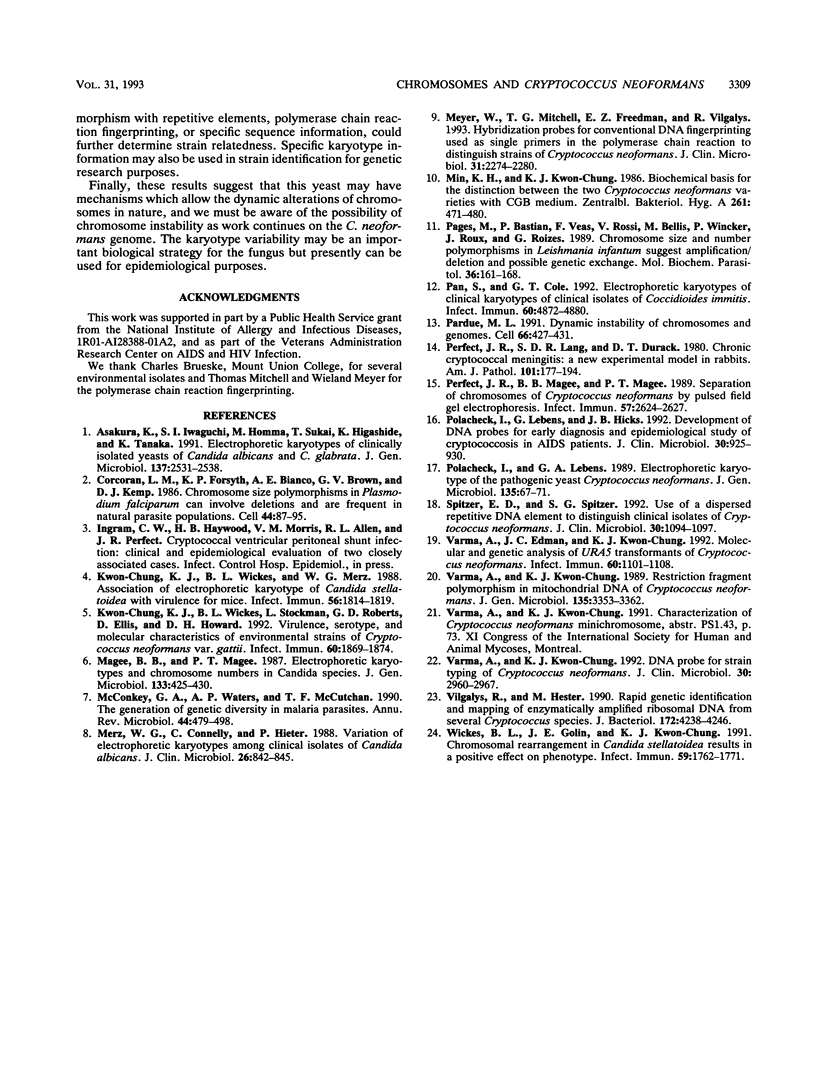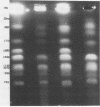Abstract
Karyotyping of Cryptococcus neoformans var. neoformans can be used as an epidemiological tool for C. neoformans infections. In this study of over 40 isolates from both clinical and environmental sources, 90% had a unique chromosome banding by pulsed-field electrophoresis. There was no conserved pattern associated with body site of infection, geographical location of the isolate, or human immunodeficiency virus status. Karyotypes of individual isolates remained stable during both in vitro passage and in vivo infections. Karyotype was used to exclude the possibility of nosocomial spread of C. neoformans in one clinical situation and supported relapse in two other cases. Because of its variable sizes between isolates, karyotyping of C. neoformans is a convenient method for molecular identification of different strains.
Full text
PDF




Images in this article
Selected References
These references are in PubMed. This may not be the complete list of references from this article.
- Asakura K., Iwaguchi S., Homma M., Sukai T., Higashide K., Tanaka K. Electrophoretic karyotypes of clinically isolated yeasts of Candida albicans and C. glabrata. J Gen Microbiol. 1991 Nov;137(11):2531–2538. doi: 10.1099/00221287-137-11-2531. [DOI] [PubMed] [Google Scholar]
- Corcoran L. M., Forsyth K. P., Bianco A. E., Brown G. V., Kemp D. J. Chromosome size polymorphisms in Plasmodium falciparum can involve deletions and are frequent in natural parasite populations. Cell. 1986 Jan 17;44(1):87–95. doi: 10.1016/0092-8674(86)90487-3. [DOI] [PubMed] [Google Scholar]
- Kwon-Chung K. J., Wickes B. L., Merz W. G. Association of electrophoretic karyotype of Candida stellatoidea with virulence for mice. Infect Immun. 1988 Jul;56(7):1814–1819. doi: 10.1128/iai.56.7.1814-1819.1988. [DOI] [PMC free article] [PubMed] [Google Scholar]
- Kwon-Chung K. J., Wickes B. L., Stockman L., Roberts G. D., Ellis D., Howard D. H. Virulence, serotype, and molecular characteristics of environmental strains of Cryptococcus neoformans var. gattii. Infect Immun. 1992 May;60(5):1869–1874. doi: 10.1128/iai.60.5.1869-1874.1992. [DOI] [PMC free article] [PubMed] [Google Scholar]
- Magee B. B., Magee P. T. Electrophoretic karyotypes and chromosome numbers in Candida species. J Gen Microbiol. 1987 Feb;133(2):425–430. doi: 10.1099/00221287-133-2-425. [DOI] [PubMed] [Google Scholar]
- McConkey G. A., Waters A. P., McCutchan T. F. The generation of genetic diversity in malaria parasites. Annu Rev Microbiol. 1990;44:479–498. doi: 10.1146/annurev.mi.44.100190.002403. [DOI] [PubMed] [Google Scholar]
- Merz W. G., Connelly C., Hieter P. Variation of electrophoretic karyotypes among clinical isolates of Candida albicans. J Clin Microbiol. 1988 May;26(5):842–845. doi: 10.1128/jcm.26.5.842-845.1988. [DOI] [PMC free article] [PubMed] [Google Scholar]
- Meyer W., Mitchell T. G., Freedman E. Z., Vilgalys R. Hybridization probes for conventional DNA fingerprinting used as single primers in the polymerase chain reaction to distinguish strains of Cryptococcus neoformans. J Clin Microbiol. 1993 Sep;31(9):2274–2280. doi: 10.1128/jcm.31.9.2274-2280.1993. [DOI] [PMC free article] [PubMed] [Google Scholar]
- Min K. H., Kwon-Chung K. J. The biochemical basis for the distinction between the two Cryptococcus neoformans varieties with CGB medium. Zentralbl Bakteriol Mikrobiol Hyg A. 1986 Jul;261(4):471–480. doi: 10.1016/s0176-6724(86)80079-7. [DOI] [PubMed] [Google Scholar]
- Pagès M., Bastien P., Veas F., Rossi V., Bellis M., Wincker P., Rioux J. A., Roizès G. Chromosome size and number polymorphisms in Leishmania infantum suggest amplification/deletion and possible genetic exchange. Mol Biochem Parasitol. 1989 Sep;36(2):161–168. doi: 10.1016/0166-6851(89)90188-6. [DOI] [PubMed] [Google Scholar]
- Pan S., Cole G. T. Electrophoretic karyotypes of clinical isolates of Coccidioides immitis. Infect Immun. 1992 Nov;60(11):4872–4880. doi: 10.1128/iai.60.11.4872-4880.1992. [DOI] [PMC free article] [PubMed] [Google Scholar]
- Pardue M. L. Dynamic instability of chromosomes and genomes. Cell. 1991 Aug 9;66(3):427–431. doi: 10.1016/0092-8674(81)90007-6. [DOI] [PubMed] [Google Scholar]
- Perfect J. R., Lang S. D., Durack D. T. Chronic cryptococcal meningitis: a new experimental model in rabbits. Am J Pathol. 1980 Oct;101(1):177–194. [PMC free article] [PubMed] [Google Scholar]
- Perfect J. R., Magee B. B., Magee P. T. Separation of chromosomes of Cryptococcus neoformans by pulsed field gel electrophoresis. Infect Immun. 1989 Sep;57(9):2624–2627. doi: 10.1128/iai.57.9.2624-2627.1989. [DOI] [PMC free article] [PubMed] [Google Scholar]
- Polacheck I., Lebens G. A. Electrophoretic karyotype of the pathogenic yeast Cryptococcus neoformans. J Gen Microbiol. 1989 Jan;135(1):65–71. doi: 10.1099/00221287-135-1-65. [DOI] [PubMed] [Google Scholar]
- Polacheck I., Lebens G., Hicks J. B. Development of DNA probes for early diagnosis and epidemiological study of cryptococcosis in AIDS patients. J Clin Microbiol. 1992 Apr;30(4):925–930. doi: 10.1128/jcm.30.4.925-930.1992. [DOI] [PMC free article] [PubMed] [Google Scholar]
- Spitzer E. D., Spitzer S. G. Use of a dispersed repetitive DNA element to distinguish clinical isolates of Cryptococcus neoformans. J Clin Microbiol. 1992 May;30(5):1094–1097. doi: 10.1128/jcm.30.5.1094-1097.1992. [DOI] [PMC free article] [PubMed] [Google Scholar]
- Varma A., Edman J. C., Kwon-Chung K. J. Molecular and genetic analysis of URA5 transformants of Cryptococcus neoformans. Infect Immun. 1992 Mar;60(3):1101–1108. doi: 10.1128/iai.60.3.1101-1108.1992. [DOI] [PMC free article] [PubMed] [Google Scholar]
- Varma A., Kwon-Chung K. J. DNA probe for strain typing of Cryptococcus neoformans. J Clin Microbiol. 1992 Nov;30(11):2960–2967. doi: 10.1128/jcm.30.11.2960-2967.1992. [DOI] [PMC free article] [PubMed] [Google Scholar]
- Varma A., Kwon-Chung K. J. Restriction fragment polymorphism in mitochondrial DNA of Cryptococcus neoformans. J Gen Microbiol. 1989 Dec;135(12):3353–3362. doi: 10.1099/00221287-135-12-3353. [DOI] [PubMed] [Google Scholar]
- Vilgalys R., Hester M. Rapid genetic identification and mapping of enzymatically amplified ribosomal DNA from several Cryptococcus species. J Bacteriol. 1990 Aug;172(8):4238–4246. doi: 10.1128/jb.172.8.4238-4246.1990. [DOI] [PMC free article] [PubMed] [Google Scholar]
- Wickes B. L., Golin J. E., Kwon-Chung K. J. Chromosomal rearrangement in Candida stellatoidea results in a positive effect on phenotype. Infect Immun. 1991 May;59(5):1762–1771. doi: 10.1128/iai.59.5.1762-1771.1991. [DOI] [PMC free article] [PubMed] [Google Scholar]







